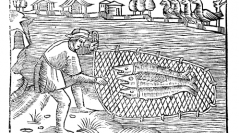

 Anthropozoologica
53 (13) - Pages 149-157
Anthropozoologica
53 (13) - Pages 149-157Indented with wide estuaries, the Picard coastline was characterized in the Middle Ages by vast sandy expanses that allowed the capturing of sea fish, of migrating or ubiquitous species or the beaching of sea mammals. That hybrid space, situated between land and water, hosted such a wealth of food supplies that lay lords would donate thousands of fresh herrings to religious communities from the northern part of the kingdom while reserving for themselves the right to capture royal species such as sturgeon, salmon or porpoise. The study of the use of aquatic animals in their medieval environment, through either archaeological or documentary sources, provides a fairly accurate yet one-sided account. Sometimes it is the analysis of bone relics, with broad faunistic range, traces of food preparation, or the identification of peak fish-capture seasons that provide useful evidence. Some other times, it is the study of texts mentioning non-bony species like sea lampreys, carrying indications of the number of captured fish or carrying testimony of fraudulent practices. The study of the use of marine animals, based on the comparison between archaeological and documentary sources, contributes to the knowledge of a particularly rich ichtyological spectrum, bringing undeniable evidence of a nourishing sea. Little is revealed however about the local avifauna whether at sea or in the estuaries. Yet it is quite useful in keeping track of the numbers of fish captured throughout the centuries and locating the areas of consumption that sometimes happened to be very far inland.
Medieval Picardy, marine fishes, migratory fishes, ubiquitous fishes, marine mammals, shellfish.